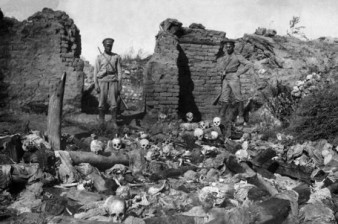
23/04/2015 12:14
Armenian Genocide: What happened, how many people died and why is it still causing debate?
By Lizzie Dearden. The Independent
As the 100th anniversary of the Armenian Genocide on 24 April approaches, the deaths of hundreds of thousands of people continues to stoke international tensions.
Mass killings at the hands of Ottoman Empire soldiers during the First World War are not disputed but historians continue to argue about whether the atrocities constituted a systematic effort to destroy ethnic Armenians.
What happened?
The Ottoman Empire, based in modern-day Turkey, was fighting the Allies as part of the Quadruple Alliance in the Middle Eastern theatre of the First World War.
Enver Pasha, the Minister of War, had publicly blamed military defeats on Armenians siding with the Russians and propaganda portrayed them as a “fifth column” working against the state.
On the orders of the government in 1915, Armenian soldiers in the Ottoman army were demobilised and transferred to “labour battalions”, where some were executed or died.
As the Russian Caucasus army marched into Anatolia, Ottoman authorities started deporting ethnic Armenians from the region, deeming them a threat to national security.
The slaughter, starvation and death that ensued claimed between 300,000 and 1.5 million Armenian lives, according to vastly differing estimates.
How did they die?
Contemporary reports listed numerous atrocities committed by Ottoman Turks, including massacres by shooting, stabbing, hanging, burning, drowning and alleged drug overdoses.
Hundreds of thousands of Armenians died in forced marches into the Syrian desert where they starved and died of thirst or disease.
Many of those who survived the journey were put into a network of 25 camps, where mass graves have subsequently been found.
The rape and sexual enslavement of Armenian women was also reported to be rife and even actively encouraged by some military commanders.
What is disputed?
Many modern-day arguments about the killings focus on the term “genocide”, with Turkey refusing to use it, claiming that the deaths were not systematic and the term was coined after the Second World War and could not be retrospectively applied.
The UN Convention on Genocide describes it as carrying out acts intended “to destroy, in whole or in part, a national, ethnic, racial or religious group” and Raphael Lemkin, who coined the term in 1943, cited atrocities against the Armenians as well as the Nazi Holocaust in his investigations.
Turkey has portrayed the killings as part of the chaos of war and claims there was no organised attempt to destroy Christian Armenians, although other states have argued that the deaths were caused by policies orchestrated by the Young Turks government.
According to the International Association of Genocide Scholars, evidence shows that the “government of the Ottoman Empire began a systematic genocide of its Armenian citizens and unarmed Christian minority population.”
“More than a million Armenians were exterminated through direct killing, starvation, torture, and forced death marches,” the group said.
Who recognises the deaths as genocide?
The governments of 24 countries, including France, Italy, Russia and Canada recognise the events as “genocide”.
The British government does not, although the regional parliaments and assemblies of Wales, Northern Ireland and Scotland do so.
Germany is set to use the term on 24 April, despite an intervention by the Turkish Prime Minister, and Austria did so this week.
Pope Francis called the massacres a genocide earlier this month, prompting Turkey to summon the Vatican's envoy and recall its own.
Countries including the US and Israel who have not previously used the term are facing calls to adopt it as the 100th anniversary approaches.
Why is it marked on 24 April?
Although the deaths continued through the First World War, 24 April 1915 was selected as the starting date of the genocide.
It was the day when the Ottoman government arrested around 250 Armenian intellectuals and community leaders in Constantinople, who were later executed
Was anyone punished?
Several senior Ottoman officials were put on trial in Turkey in 1919 in connection with the atrocities but the Young Turks' leading trio had already fled abroad and were sentenced to death in absentia.
Historians have since questioned the judicial process at the time, when Turkish authorities are accused of attempting to appease the victorious Allies.








